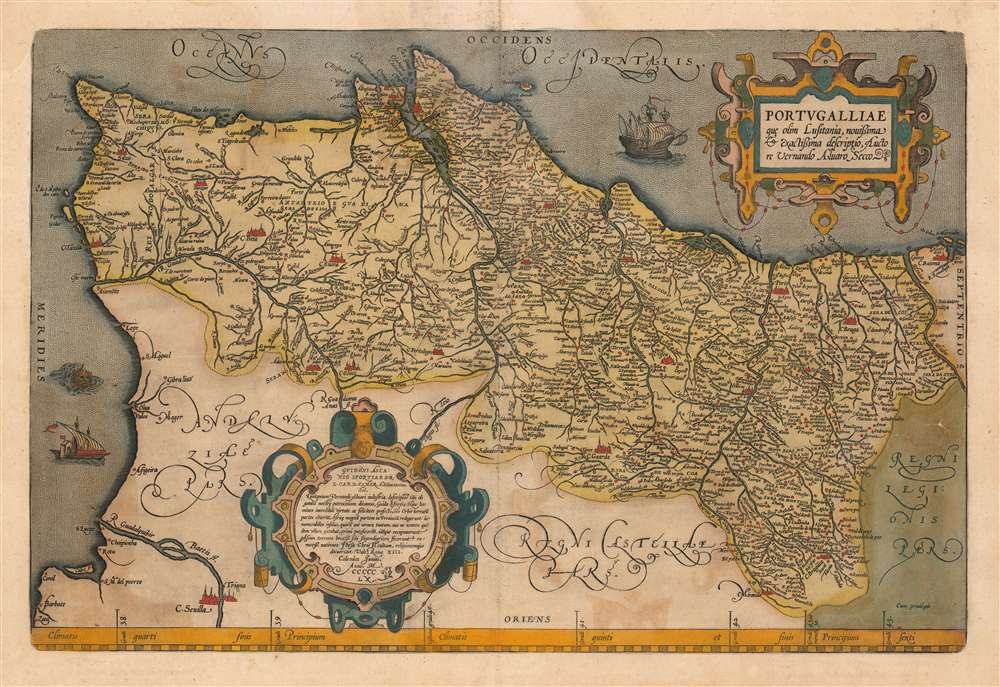This item has been sold, but you can get on the Waitlist to be notified if another example becomes available, or purchase a digital scan.
1612 Ortelius Map of Portugal
Portugal-ortelius-1570
Title
1570 (undated) 13.5 x 20 in (34.29 x 50.8 cm) 1 : 1200000
Description
The Source
Ortelius' source for this map was the Portugal map drawn by Ferdinand Alvares Seco, probably the unacquirable 1565 De Jode issue. Ortelius reproduces not only the geography of the Seco map (including its westward orientation), but its dedication to Cardinal Guido Sforza by Portuguese humanist Achilles Estaço, who would become the cardinal's librarian between 1562 and 1564 (evidently, Estaço's 1561 flattery of Sforza worked). The date of the dedication corresponds to the day (May 20, 1560) when the Portuguese ambassador, Lourenço Pires de Távora, gave the oath of loyalty to the Pope on behalf of the young King Sebastian. The correlation of these dates suggests that the Alvaro Seco map represented an official, perhaps a royal publication. Although Ortelius' edition is not the first printed map of Portugal, it is arguably the most influential. While the Trammezino and De Jode maps of the 1560s are vanishingly rare, Ortelius' map would be the first to be included in a published atlas. Consequently it is through Ortelius' Theatrum Orbis Terrarum that Alvaro Seco's cartography reached a broad audience, and it through Ortelius that it was copied by Hondius and Blaeu throughout the seventeenth century and beyond.Publication History and Census
This map was engraved for inclusion in the first, May 1570 edition of Ortelius' atlas and appeared in every edition of that work into the 17th century. This example's additional stippling around the place names in ocean areas identifies it as a third state, according to Van den Broecke. It corresponds typographically to the 1612 Latin edition, published by Plantin. In its various editions it is well represented in institutional collections. Examples do appear on the market, however original color examples grow scarce.CartographerS
Abraham Ortelius (April 14, 1527 - June 28, 1598) also known as Ortels, was a cartographer, geographer, and cosmographer of Brabant, active in Antwerp. He was the creator of the first modern atlas, Theatrum Orbis Terrarum and is a seminal figure in the history of cartography. Along with Gerard Mercator and Gemma Frisius, he was a founder of the Netherlandish school of cartography. His connections with Spain - culminating in his 1575 appointment as Royal Cartographer to King Phillip II of Spain - gave him unmatched access to Spanish geographical knowledge during a crucial period of the Age of Discovery. Ortelius was born in 1527 in Antwerp. In 1547 he entered the Antwerp Guild of Saint Luke as an illuminator of maps. He began trading in books, prints, and maps, traveling regularly to the Frankfurt book and print fair, where in 1554 he met Mercator. He accompanied Mercator on journeys throughout France in 1560 and it was at this time, under Mercator's influence, that he appears to have chosen his career as a scientific geographer. His first published geographic work appeared in 1564, an eight-sheet cordiform world map. A handful of other maps preceded the 1570 publication of the first edition of the Theatrum Orbis Terrarum, which would prove to be his life work. Appearing with but 53 maps in its first edition, Ortelius' work expanded with new maps added regularly. By 1592, it had 134 maps. Many of Ortelius' maps remained the standard for nearly a century. He traveled extensively, but his genius was as a compiler, locating the best informed maps on which to base his own. His contacts throughout Europe and extending even (via the Portuguese) to the Far East were formidable. Moreover, many of his maps were based on his own scholarship, particularly his historical works. His theories of geography were particularly ahead of his time with respect to the notion of continental drift, the possibility of which he mused on as early as 1596, and which would be proven correct centuries later.
In a sense his greatest achievement was his successful navigation of the religious and political violence endemic to his city throughout his adult life: The Dutch Revolt, or Eighty Years' War (1568 - 1648), fully embroiled Antwerp. Although outwardly and officially recognized as Catholic (Arias Montanus vouched for Ortelius' Catholic orthodoxy prior to his appointment as Royal Geographer), Ortelius was able to separate himself from the religious furor which characterized the war in the low countries. Ortelius showed a glimpse of himself in a letter to a friend, regarding humanist Justus Lipsius: 'I do not know whether he is an adherent of the Pope or a Calvinist, but if he has ears to hear, he will neither be one nor the other, for sins are committed on both sides'. Ortelius' own explorations of Biblical history in his maps, and the Christogram contained in his own motto, suggest him to be a religious man, but his abjuration of political religious authorities mark him as an individualist. His tombstone at St Michael's Præmonstratensian Abbey in Antwerp bears the inscription, Quietis cultor sine lite, uxore, prole. ('served quietly, without accusation, wife, and offspring.') More by this mapmaker...
Ferdinand Alvares Seco (fl. 1560) also Fernando Álvaro Seco, was responsible for drafting the first separate map of Portugal. The first printed versions of his work were dedicated to the Milanese Cardinal Guido Sforza, so it is sometimes thought that he was a member of the Sforzas' court in Milan - it is more likely that he was Portuguese, and the map's dedication to Sforza was tendered by the Cardinal's prospective librarian. Virtually nothing is known with certainty about Alvaro Seco beyond his map, which remained the source map for almost every subsequent map of Kingdom of Portugal for over a century. Learn More...

